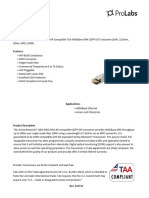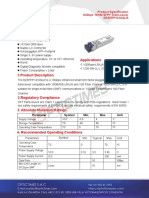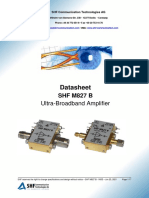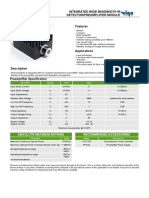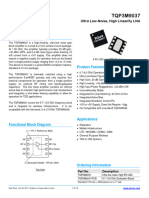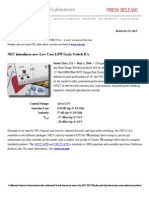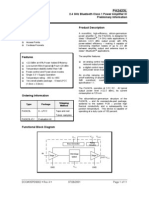ZMN 2430
ZMN 2430
Uploaded by
BogdanCopyright:
Available Formats
ZMN 2430
ZMN 2430
Uploaded by
BogdanOriginal Title
Copyright
Available Formats
Share this document
Did you find this document useful?
Is this content inappropriate?
Copyright:
Available Formats
ZMN 2430
ZMN 2430
Uploaded by
BogdanCopyright:
Available Formats
DEVELOPMENT KIT
(Info Click here)
ZMN2430
• 2.4 GHz ZigBee Transceiver Module
• Small Size, Light Weight, Low Cost
• Sleep Current less than 3 µA
• FCC and ETSI Certified for Unlicensed Operation ZigBee
Transceiver
Module
The ZMN2430 2.4 GHz transceiver module is a low cost solution for point-to-point,
point-to-multipoint and MESH wireless systems. The ZMN2430 module provides the
flexibility and versatility to serve applications ranging from cable replacements to
sensor networks. Based on the IEEE 802.15.4 wireless standard and the ZigBee
protocol stack, the ZMN2430 module is easy to integrate and provides robust wire-
less communications including MESH network operation. The ZMN2430 also in-
cludes RFM’s powerful CSM application profile, which eliminates the need for
customer firmware programming.
ZMN2430 Absolute Maximum Ratings
Rating Value Units
All Input/Output Pins -0.3 to +3.6 V
o Shown with Shield Removed
Non-Operating Ambient Temperature Range -40 to +85 C
ZMN2430 Electrical Characteristics
Characteristic Sym Notes Minimum Typical Maximum Units
Operating Frequency Range 2405 2480 MHz
Operating Frequency Tolerance -300 300 kHz
Spread Spectrum Method Direct Sequence
Modulation Type O-QPSK
Number of RF Channels 16
RF Data Transmission Rate 250 kb/s
Symbol Rate Tolerance 120 ppm
RF Channel Spacing 5 MHz
Receiver Sensitivity, 10E-5 BER -92 dBm
Upper Adjacent Channel Rejection, +5 MHz 41 dB
Lower Adjacent Channel Rejection, -5 MHz 30 dB
Upper Alternate Channel Rejection, +10 MHz 55 dB
Lower Alternate Channel Rejection, -10 MHz 53 dB
Maximum RF Transmit Power -3 0 dBm
Transmit Power Adjustment 26 dB
Optimum Antenna Impedance 50 Ω
www.RFM.com E-mail: info@rfm.com Page 1 of 6
©2008 by RF Monolithics, Inc. ZMN2430 - 3/10/08
ZMN2430 Electrical Characteristics
Characteristic Sym Notes Minimum Typical Maximum Units
ADC Input Range 0 3.3 V
ADC Input Resolution 7 12 bits
ADC Input Impedance 55 MΩ
PWM Output Resolution 12 bits
UART Baud Rate 1.2 115.2 kb/s
Digital I/O:
Logic Low Input Level -0.3 0.5 V
Logic High Input Level 2.8 3.6 V
Logic Input Internal Pull-up/Pull-down Resistor 20 KΩ
GPIO3 Logic Low Sink Current 20 mA
Power Supply Voltage Range VCC +3.3 +5.5 Vdc
Power Supply Voltage Ripple 10 mVP-P
Receive Mode Current 27 mA
Transmit Mode Current 28 mA
Sleep Mode Current 3 µA
o
Operating Temperature Range -40 85 C
CAUTION: Electrostatic Sensitive Device. Observe precautions when handling.
www.RFM.com E-mail: info@rfm.com Page 2 of 6
©2008 by RF Monolithics, Inc. ZMN2430 - 4/17/08
Z M N 2 4 3 0 B lo c k D ia g r a m
G N D 1 3 2 .7 6 8 k H z 3 2 M H z
R S V D 2
R S V D 3
G P IO 0 4
U A R T _ T X 5
U A R T _ R X 6 2 8
T X /R X
C C 2 4 3 0 C o m b in e r 2 9
G P IO 4 7 R F IO
8 0 2 .1 5 .4 3 0
G P IO 5 8 R a d io a n d
P W M A 9 F ilte r M ic r o c o n tr o lle r
G P IO 2 1 0
G P IO 1 1 1
G P IO 3 1 2
P W M B 1 3 F ilte r
V C C 1 4 R e g
G N D 1 5
+ 3 .3 V
1 6 1 7 1 8 1 9 2 0 2 1 2 2 2 3 2 4 2 5 2 6 2 7
N C
N C
R E S E T
S P I_ E N
S P I_ S C L K
S P I_ M IS O
S P I_ M O S I
G N D
A D C 1
A D C 2
A D C R E F
A D C 0
Figure 1
ZMN2430 Hardware tocol stack implements networking and security, with
The major hardware component of the ZMN2430 is underlying support from the 802.15.4 Media Access
the CC2430 IEEE 802.15.4 compatible transceiver Control (MAC) layer. The standard ZMN2430 firmware
with integrated 8051 microcontroller. The ZMN2430 implements a ZigBee full function device (FFD). This
operates in the frequency band of 2405 to 2480 MHz allows the module to operate as either a coordinator or
at a nominal output power of 1 mW. router. Optional ZMN2430 firmware is available that
implements a ZigBee reduced function device (RFD).
Two crystals are provided to operate the CC2430, a This allows the module to operate as an end device.
32 MHz crystal for normal operation and a 32.768 kHz The CSM profile provides an application programming
crystal for precision sleep mode operation. interface (API) for all the ZMN2430 application hard-
The ZMN2430 provides a variety of application hard- ware interfaces. The CSM profile includes Network
ware interfaces including an SPI interface, UART in- Discovery, Send/Receive Serial Data, Read/Write SPI
terface, three 12-bit ADC inputs, two PWM (DAC) Port, Read ADC Inputs, Write DAC Outputs,
outputs, and six general purpose digital I/O ports. Read/Write GPIO and Module Configuration services.
In addition, the CSM profile provides two sleep modes
ZMN2430 Firmware - timer sleep and interrupt sleep. See the ZMN2430
The main firmware components in the ZMN2430 ZigBee Module Developer’s Kit User’s Manual for
include the ZigBee protocol stack and RFM’s CSM complete details of the CSM profile API.
Standard Module application profile. The ZigBee pro-
www.RFM.com E-mail: info@rfm.com Page 3 of 6
©2008 by RF Monolithics, Inc. ZMN2430 - 4/17/08
ZMN2430 I/O Pad Descriptions
Pad Name Description
1 GND Power supply and signal ground. Connect to the host circuit board ground.
2 RSVD Reserved pin. Leave unconnected.
3 RSVD Reserved pin. Leave unconnected.
4 GPIO0 Configurable digital I/O port 0. When configured as an output, the power-on state is also configurable.
5 UART_TX Serial data output from UART.
6 UART_RX Serial data input to UART.
7 GPIO4 Configurable digital I/O port 4. When configured as an output, the power-on state is also configurable.
8 GPIO5 Configurable digital I/O port 5. When configured as an output, the power-on state is also configurable.
9 PWMA Pulse-width modulated output A with internal low-pass filter. Provides a DAC function.
10 GPIO2 Configurable digital I/O port 2. When configured as an output, the power-on state is also configurable.
11 GPIO1 Configurable digital I/O port 1. When configured as an output, the power-on state is also configurable.
Configurable digital I/O port 3. When configured as an output, this high current port can sink up to 20 mA. The
12 GPIO3
power-on output state is also configurable.
13 PWMB Pulse-width modulated output B with internal low-pass filter. Provides a DAC function.
14 VCC Power supply input, +3.3 to +5.5 Vdc.
15 GND Power supply and signal grounds. Connect to the host circuit board ground.
16 GND Power supply and signal grounds. Connect to the host circuit board ground.
17 /RESET Active low module hardware reset. Hold this input low when the power supply input is less than 2.7 Vdc.
7-bit to 12-bit ADC input 0. ADC full scale reading can be referenced to the module’s +3.3 V regulated supply or
18 ADCX
to the ADC’s internal +2.5 V reference.
7-bit to 12-bit ADC input 1. ADC full scale reading can be referenced to the module’s +3.3 V regulated supply or
19 ADCY
to the ADC’s internal +2.5 V reference.
20 SPI_MISO SPI port data input.
21 SPI_MOSI SPI port data output.
22 SPI_EN Active-low enable output for SPI bus devices.
23 SPI_SCLK SPI port clock signal.
7-bit to 12-bit ADC input 2. ADC full scale reading can be referenced to the module’s +3.3 V regulated supply or
24 ADCZ
to the ADC’s internal +2.5 V reference.
Module’s +3.3 V regulated supply, used for ratiometric ADC readings. Current drain on this output should be no
25 ADC REF
greater than 5 mA.
26 NC No connection.
27 NC No connection.
28 GND RF ground. Connect to the host circuit board ground plane, and to shield when using coaxial cable.
29 RFIO RF port. Connect the antenna to this port with a 50 Ω stripline or semi-rigid coaxial cable.
30 GND RF ground. Connect to the host circuit board ground plane, and to shield when using coaxial cable.
www.RFM.com E-mail: info@rfm.com Page 4 of 6
©2008 by RF Monolithics, Inc. ZMN2430 - 4/17/08
RFIO Stripline
The RFIO pad on the radio module is connected directly to an antenna on the host circuit board, or to an MMCX
or similar RF connector. It is important that this connection be implemented as a 50 ohm stripline. Referring to
Figure 3, the width of this stripline depends on the thickness of the circuit board between the stripline and the
Z M N 2 4 3 0 O u tlin e a n d M o u n tin g D im e n s io n s
0 .8
0 .0 5
0 .0 4
1 5 1
0 .0 3
T o p V ie w 0 .9 8 5
1 6 3 0
0 .1 2
D im e n s io n s in in c h e s
Figure 2
groundplane. For FR-4 type circuit board materials (dielectric constant of 4.7), the width of the stripline is equal to
1.75 times the thickness of the circuit board. Note that other circuit board traces should be spaced away from the
stripline to prevent signal coupling, as shown in Figure 4. The stripline trace should be kept short to minimize its
insertion loss.
C ir c u it B o a r d S tr ip lin e T r a c e D e ta il Trace Separation from Length of Trace Run
50 Ohm Microstrip Parallel to Microstrip
C o p p e r
S tr ip lin e 100 mil 125 mil
T ra c e
150 mil 200 mil
200 mil 290 mil
C o p p e r 250 mil 450 mil
G ro u n d
P la n e F R -4 P C B
M a te r ia l
300 mil 650 mil
F o r 5 0 o h m im p e d a n c e W = 1 .7 5 * H
Figure 3 Figure 4
www.RFM.com E-mail: info@rfm.com Page 5 of 6
©2008 by RF Monolithics, Inc. ZMN2430 - 4/17/08
Reflow Profile
An example solder reflow profile for mounting the radio module on its host circuit board is shown in Figure 5.
Figure 5
Note: Specifications subject to change without notice.
www.RFM.com E-mail: info@rfm.com Page 6 of 6
©2008 by RF Monolithics, Inc. ZMN2430 - 4/17/08
You might also like
- Design Project 4Document2 pagesDesign Project 4gelodiaz940% (1)
- Pixel Slate ManualDocument5 pagesPixel Slate ManualDaniel TysonNo ratings yet
- Maam 010373-318010Document11 pagesMaam 010373-318010Fehmi YOUSFINo ratings yet
- (2600 MHZ) COMMSCOPE E15S09P54Document4 pages(2600 MHZ) COMMSCOPE E15S09P54MARIONo ratings yet
- xfp-sm55tg-a2dcDocument7 pagesxfp-sm55tg-a2dcGerman RodriguezNo ratings yet
- Anexa 1 QXP85A4-03D-VIDocument14 pagesAnexa 1 QXP85A4-03D-VIstelea7577No ratings yet
- Product Specification 10Gbps CWDM BIDI Transceiver CLS10GCWBD10-XX/XXDocument8 pagesProduct Specification 10Gbps CWDM BIDI Transceiver CLS10GCWBD10-XX/XXOsazuwa OmoiguiNo ratings yet
- Sa818 PDFDocument8 pagesSa818 PDFDARU WIRANTONo ratings yet
- E14R00P02 1800MHz MHADocument5 pagesE14R00P02 1800MHz MHA'Theodora GeorgianaNo ratings yet
- GX 55192 ZRCDocument8 pagesGX 55192 ZRCcristovaojuniorNo ratings yet
- QSFP28-100G-LR4 100Gb/s QSFP28 LR4 Transceiver: Product FeaturesDocument8 pagesQSFP28-100G-LR4 100Gb/s QSFP28 LR4 Transceiver: Product Featuresthaithuy_gtvtNo ratings yet
- RXQ1Document3 pagesRXQ1محمد خدائیNo ratings yet
- GPON Mikrotik Datasheet PDFDocument3 pagesGPON Mikrotik Datasheet PDFJ.c. FrancoNo ratings yet
- SFP 34060713-001Document6 pagesSFP 34060713-001parsa ramezanNo ratings yet
- 377.0189.00 - SFP (150km)Document7 pages377.0189.00 - SFP (150km)cristovaojuniorNo ratings yet
- QSFP 40G SR4Document9 pagesQSFP 40G SR4Trần Đăng KhoaNo ratings yet
- Datasheet: SFP DWDM 40 KM Transceiver - 4G LX Fiber ChannelDocument6 pagesDatasheet: SFP DWDM 40 KM Transceiver - 4G LX Fiber ChannellitoduterNo ratings yet
- QPF4001 Data SheetDocument21 pagesQPF4001 Data SheetNhat Tran XuanNo ratings yet
- Cfp 100g Sr10 c Datasheets EnDocument9 pagesCfp 100g Sr10 c Datasheets EnVictor nguyenNo ratings yet
- 10g-Base-Lr-1310nm BrocadeCompatible 10G SFP 22mac21Document15 pages10g-Base-Lr-1310nm BrocadeCompatible 10G SFP 22mac21alfian sofianNo ratings yet
- Andrew E15Z01P06 (ETD819H-12UB) TMA spec sheetDocument6 pagesAndrew E15Z01P06 (ETD819H-12UB) TMA spec sheetharellanoNo ratings yet
- Part Number: SFP-1000Base-LX SFP-1000Base-LX-INDDocument3 pagesPart Number: SFP-1000Base-LX SFP-1000Base-LX-INDPatrick LaoNo ratings yet
- OPB1250-355320xxR DSDocument7 pagesOPB1250-355320xxR DSdavidNo ratings yet
- Reference For IR1 IR2 SFP-OC48-IR2-GT Spec SheetDocument7 pagesReference For IR1 IR2 SFP-OC48-IR2-GT Spec SheetSai Krishna SNo ratings yet
- Features: 1gbase, SFP, ZX, (SM) 1550 NM, 70 KM REACH, LCDocument8 pagesFeatures: 1gbase, SFP, ZX, (SM) 1550 NM, 70 KM REACH, LCmanuelsalinas777_753No ratings yet
- Huawei 0231A0A7 DatasheetDocument4 pagesHuawei 0231A0A7 DatasheetSABIRNo ratings yet
- Empower RF Amplifier 1124Document3 pagesEmpower RF Amplifier 1124trilok347No ratings yet
- QDD 400G DR4 AR C - Datasheets - ENDocument10 pagesQDD 400G DR4 AR C - Datasheets - ENobamab69No ratings yet
- OZ810Document5 pagesOZ810kanat_altimimiNo ratings yet
- 6C SFP 0320 PDFDocument9 pages6C SFP 0320 PDFizziah skandarNo ratings yet
- Narrow Band Radio Transceiver 434 MHZ: PreliminaryDocument1 pageNarrow Band Radio Transceiver 434 MHZ: PreliminaryStanley Ochieng' OumaNo ratings yet
- TX 1Document4 pagesTX 1api-3778302100% (1)
- SFP+ 10Gbps BiDi TX1270RX1330nm 40KMDocument7 pagesSFP+ 10Gbps BiDi TX1270RX1330nm 40KMpeng chenNo ratings yet
- Intel Ethernet SFP28 Optics Product BriefDocument8 pagesIntel Ethernet SFP28 Optics Product BriefDEBNo ratings yet
- DSM 10GLRDocument9 pagesDSM 10GLRombidasar89No ratings yet
- 6C WDM 0220BDDocument7 pages6C WDM 0220BDNugi Anugrah M1221562No ratings yet
- Product Data Sheet0900aecd806c4b1aDocument8 pagesProduct Data Sheet0900aecd806c4b1aオチョア フランクNo ratings yet
- Finisar FTLF8519P3BNL DatasheetDocument4 pagesFinisar FTLF8519P3BNL DatasheetSamuel OsorioNo ratings yet
- SA868 2W Embedded Walkie Talkie ModuleV1.2Document16 pagesSA868 2W Embedded Walkie Talkie ModuleV1.2Chakphanu KomasathitNo ratings yet
- SBB5089Z Data SheetDocument11 pagesSBB5089Z Data SheetQuyNo ratings yet
- DataSheet OPTICTIMESDocument5 pagesDataSheet OPTICTIMESelvis alvites artica ciprianoNo ratings yet
- Datasheet: Ultra-Broadband AmplifierDocument17 pagesDatasheet: Ultra-Broadband AmplifiercarlosNo ratings yet
- Rfso S A0010099186 1-2576209Document4 pagesRfso S A0010099186 1-2576209lumisoftNo ratings yet
- Andrew ETB19G8-12UB Product SpecificationDocument6 pagesAndrew ETB19G8-12UB Product SpecificationharellanoNo ratings yet
- QDD 400G VSR4 C - Datasheets - ENDocument10 pagesQDD 400G VSR4 C - Datasheets - ENobamab69No ratings yet
- SFP 20kmDocument10 pagesSFP 20kmHậu NguyễnNo ratings yet
- Anexa 6 QXP27A4-02D-VIDocument14 pagesAnexa 6 QXP27A4-02D-VIstelea7577No ratings yet
- 1550nm / 80km /: SPP15080100D - SFP+ Dual FibreDocument4 pages1550nm / 80km /: SPP15080100D - SFP+ Dual FibreJose JaramilloNo ratings yet
- DWDM Multirate SFP Transceivers: DatasheetDocument5 pagesDWDM Multirate SFP Transceivers: DatasheetCarlos CoronelNo ratings yet
- Syrotech 80Km CWDM SFP+ Optical Transceiver Goxp-Cwdmxx96-80Document9 pagesSyrotech 80Km CWDM SFP+ Optical Transceiver Goxp-Cwdmxx96-80chandan kumar SinghNo ratings yet
- TQP3M9009: ApplicationsDocument10 pagesTQP3M9009: ApplicationsGuilherme Ribeiro BarbosaNo ratings yet
- 377.0195.00 - SFP Bi-Directional (120Km)Document8 pages377.0195.00 - SFP Bi-Directional (120Km)cristovaojuniorNo ratings yet
- SFP 1G Bidi: SFP, BIDI, 1.25G, 1490/1550NM, 120KM, SMF, DDM SFP, BIDI, 1.25G, 1550/1490NM, 120KM, SMF, DDMDocument11 pagesSFP 1G Bidi: SFP, BIDI, 1.25G, 1490/1550NM, 120KM, SMF, DDM SFP, BIDI, 1.25G, 1550/1490NM, 120KM, SMF, DDMprisara0104No ratings yet
- Slc-25-C-1-X-R6 Optical Transceiver: Infiniband Applications - 2.5 Gbaud 850Nm SFF 2X5, +3.3VDocument3 pagesSlc-25-C-1-X-R6 Optical Transceiver: Infiniband Applications - 2.5 Gbaud 850Nm SFF 2X5, +3.3Vkhan afNo ratings yet
- SA818 DatasheetDocument6 pagesSA818 DatasheetDare DoreNo ratings yet
- Nice RFDocument17 pagesNice RFmuhammadsubarkah3No ratings yet
- RR017 - 2-18 GHZ Radar Warning ReceiverDocument7 pagesRR017 - 2-18 GHZ Radar Warning Receiveralfikymostafa92No ratings yet
- Terrasat Ku-Band IBUC R Datasheet 061019Document2 pagesTerrasat Ku-Band IBUC R Datasheet 061019arzeszutNo ratings yet
- Integrated Wide Bandwidth Ir Detector/Preamplifier ModuleDocument2 pagesIntegrated Wide Bandwidth Ir Detector/Preamplifier ModulemiclausamNo ratings yet
- TQP3M9037 Data SheetDocument16 pagesTQP3M9037 Data SheetMarcus HoangNo ratings yet
- GPON_180331Document4 pagesGPON_180331esNo ratings yet
- Upg 2214 TKDocument1 pageUpg 2214 TKBogdanNo ratings yet
- SG 46Document156 pagesSG 46BogdanNo ratings yet
- SPSSG 1009Document32 pagesSPSSG 1009Bogdan100% (1)
- Pa2423l BriefDocument1 pagePa2423l BriefBogdanNo ratings yet
- Smart ModemDocument4 pagesSmart ModemBogdan100% (1)
- Pa2423u BriefDocument1 pagePa2423u BriefBogdanNo ratings yet
- 2.4 GHZ Bluetooth Class 1 Power Amplifier Ic Preliminary InformationDocument12 pages2.4 GHZ Bluetooth Class 1 Power Amplifier Ic Preliminary InformationBogdan100% (1)
- WLC Product Portfolio 0803Document1 pageWLC Product Portfolio 0803BogdanNo ratings yet
- Product Application+Guide 2007Document242 pagesProduct Application+Guide 2007Bogdan100% (1)
- MBC 13720 FactDocument2 pagesMBC 13720 FactBogdanNo ratings yet
- Wireless-: User GuideDocument99 pagesWireless-: User GuideBogdanNo ratings yet
- Webtalker 6000 Qig d85Document425 pagesWebtalker 6000 Qig d85Bogdan100% (2)
- Wip320 DsDocument2 pagesWip320 DsBogdanNo ratings yet
- Stylish, Full-Featured Mobile Wifi Phone For Voip Service: Product Data Wireless-G Ip PhoneDocument4 pagesStylish, Full-Featured Mobile Wifi Phone For Voip Service: Product Data Wireless-G Ip PhoneBogdanNo ratings yet
- Wip330 QiDocument2 pagesWip330 QiBogdanNo ratings yet
- Pha MGW Rfman 10Document81 pagesPha MGW Rfman 10BogdanNo ratings yet
- Stylish, Full-Featured Mobile Wifi Phone For Voip Service: Product Data Wireless-G Ip PhoneDocument4 pagesStylish, Full-Featured Mobile Wifi Phone For Voip Service: Product Data Wireless-G Ip PhoneBogdanNo ratings yet
- Application Note - Analysis of An 868 MHZ Loop AntennaDocument10 pagesApplication Note - Analysis of An 868 MHZ Loop AntennaBogdan100% (1)
- Computer For ABEDocument8 pagesComputer For ABELyka Mae MancolNo ratings yet
- Pso2 DxdiagDocument10 pagesPso2 DxdiaglunarsaleNo ratings yet
- Toshiba 20AF46, 20AF46CDocument62 pagesToshiba 20AF46, 20AF46Cjose salasNo ratings yet
- Recitation 3Document2 pagesRecitation 3youyatgilNo ratings yet
- II II Results (R13)Document77 pagesII II Results (R13)Phani KumarNo ratings yet
- Custom PC - December 2019Document118 pagesCustom PC - December 2019Ge LouNo ratings yet
- Ic 8279Document3 pagesIc 8279Akshat KaleNo ratings yet
- Hyper Ser DriveDocument10 pagesHyper Ser DriveRommel100% (1)
- Pawpaw: Analog ReinventedDocument64 pagesPawpaw: Analog ReinventedНиколайNo ratings yet
- 05 Inter RAT Cell Reselection and Handover 59Document59 pages05 Inter RAT Cell Reselection and Handover 59Islam Barakat100% (1)
- Consumer Mobility: GSM Radio ConceptDocument47 pagesConsumer Mobility: GSM Radio ConceptglobalkapoorNo ratings yet
- ASTM G57 06 R2012 Standard Test Method For Field Measurement of Soil Resistivity Using The Wenner Four Electrode MethodDocument2 pagesASTM G57 06 R2012 Standard Test Method For Field Measurement of Soil Resistivity Using The Wenner Four Electrode MethodComercial Certa InternacionalNo ratings yet
- Differential RelaysDocument9 pagesDifferential RelaysMrNo ratings yet
- Listening To Your System - Pioneer A-A9MK2-K ManualDocument2 pagesListening To Your System - Pioneer A-A9MK2-K ManualAUDIO DesignerNo ratings yet
- BEEEDocument130 pagesBEEEPriyanka RathoreNo ratings yet
- Schneider Voltage TransformerDocument1 pageSchneider Voltage TransformerAhmad Dakhil0% (1)
- DSP Processor FundementalsDocument210 pagesDSP Processor FundementalsHaluk Özduman100% (3)
- FVR 3001M Eng PDFDocument2 pagesFVR 3001M Eng PDFAntonio OrdazNo ratings yet
- Reliance Placement Paper PDFDocument6 pagesReliance Placement Paper PDFHitesh Himanshu100% (1)
- Different Types of Transistor: Name Definitio N Schematic Symbol Illustration PurposeDocument4 pagesDifferent Types of Transistor: Name Definitio N Schematic Symbol Illustration PurposeRachel MonesNo ratings yet
- Expt1 - HWR and FWRDocument10 pagesExpt1 - HWR and FWRMaheswariRVNo ratings yet
- OLEDsDocument2 pagesOLEDsMerita DemaNo ratings yet
- View Available Choices HandlerDocument2 pagesView Available Choices Handlerchakrabortysarthak6No ratings yet
- Digitalisation of Cable TVDocument23 pagesDigitalisation of Cable TVManish DiwaleNo ratings yet
- Fpga Implementation of A Zigbee Wireless Network Control Interface To Transmit Biomedical SignalsDocument11 pagesFpga Implementation of A Zigbee Wireless Network Control Interface To Transmit Biomedical SignalsLalo AngelNo ratings yet
- Superheterodyne AM/ FM Receivers, Local Carrier SynchronizationDocument11 pagesSuperheterodyne AM/ FM Receivers, Local Carrier SynchronizationRANJEET PATELNo ratings yet
- LabDocument15 pagesLabVinitKharkarNo ratings yet
- Secured Smart Healthcare Monitoring System Based On IotDocument25 pagesSecured Smart Healthcare Monitoring System Based On IotSuhas Kapse64% (11)



























